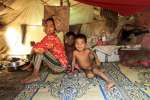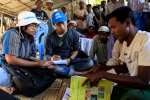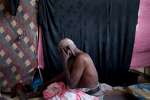- Text size
 |
|  |
|  |
| 
- Français
African Union set to adopt groundbreaking Convention on the internally displaced
News Stories, 22 October 2009
KAMPALA, Uganda, October 22 (UNHCR) – The African Union (AU) opened a visionary summit meeting here today to address the festering problem of forced displacement on the African Continent.
In a keynote address to the Special Summit of Heads of State and Government on Refugees, Returnees and Internally Displaced Persons, Ugandan President Yoweri Kaguta Museveni said, "No country should be allowed to disown its own people."
The attending African leaders are expected to sign on Friday a groundbreaking legal framework titled, "Convention for the Protection and Assistance of Internally Displaced Persons in Africa." The new convention, if adopted, defines and emphasizes the responsibilities that states, and even armed groups, have to protect and assist their own uprooted citizens.
Beyond armed conflict, the convention covers major causes of displacement, including obligations that governments have toward their citizens fleeing natural and man-made disasters and people removed from their land when development projects take over. People forced to flee will find in the convention the full range of rights they should be entitled to – before, during and after displacement.
"Everyone displaced by conflict or natural disaster is an individual. A person, likely a woman or a child, who may be undernourished and living in fear of recruitment or rape. A person whose potential remains unrealized, with dreams unfulfilled and contributions foregone. You have come together to forge a better future," UN High Commissioner for Refugees António Guterres told the summit. "Once again, Africa is leading the way forward," added the High Commissioner, who was speaking on behalf of UN Secretary-General Ban Ki-moon.
Continuing in his capacity as High Commissioner, Guterres said, "Let us draw inspiration from those African leaders who have refused to accept perpetual displacement as an inevitable reality in their countries and have acted boldly to bring it to an end. Refugee status and internal displacement must not be an inheritance that is handed down from one generation to the next."
The convention will enter into force following ratification or accession by at least 15 AU member states. "The big challenge now will be to implement it," said Walter Kaelin, the UN Secretary-General's representative on the human rights of internally displaced people (IDP).
In his address to the summit, UN Under-Secretary General for Humanitarian Affairs and Emergency Relief Coordinator Sir John Holmes noted, "The true measure of the success of this summit and the convention will be when we start to see a reduction in the scale of displacement, and more effective solutions for those who have been displaced – and above all an end to the enormous suffering that this has brought to so many people in this continent."
The phenomenon of internal displacement continues to expand on the African continent, even as refugee numbers progressively decline. At the beginning of this year, Africa was home to an estimated 11.6 million internally displaced people, or about 45 percent of the world's IDPs. The continent also has some 2,659,000 refugees and asylum-seekers. Some 2 million people were newly displaced during the course of last year.

















































